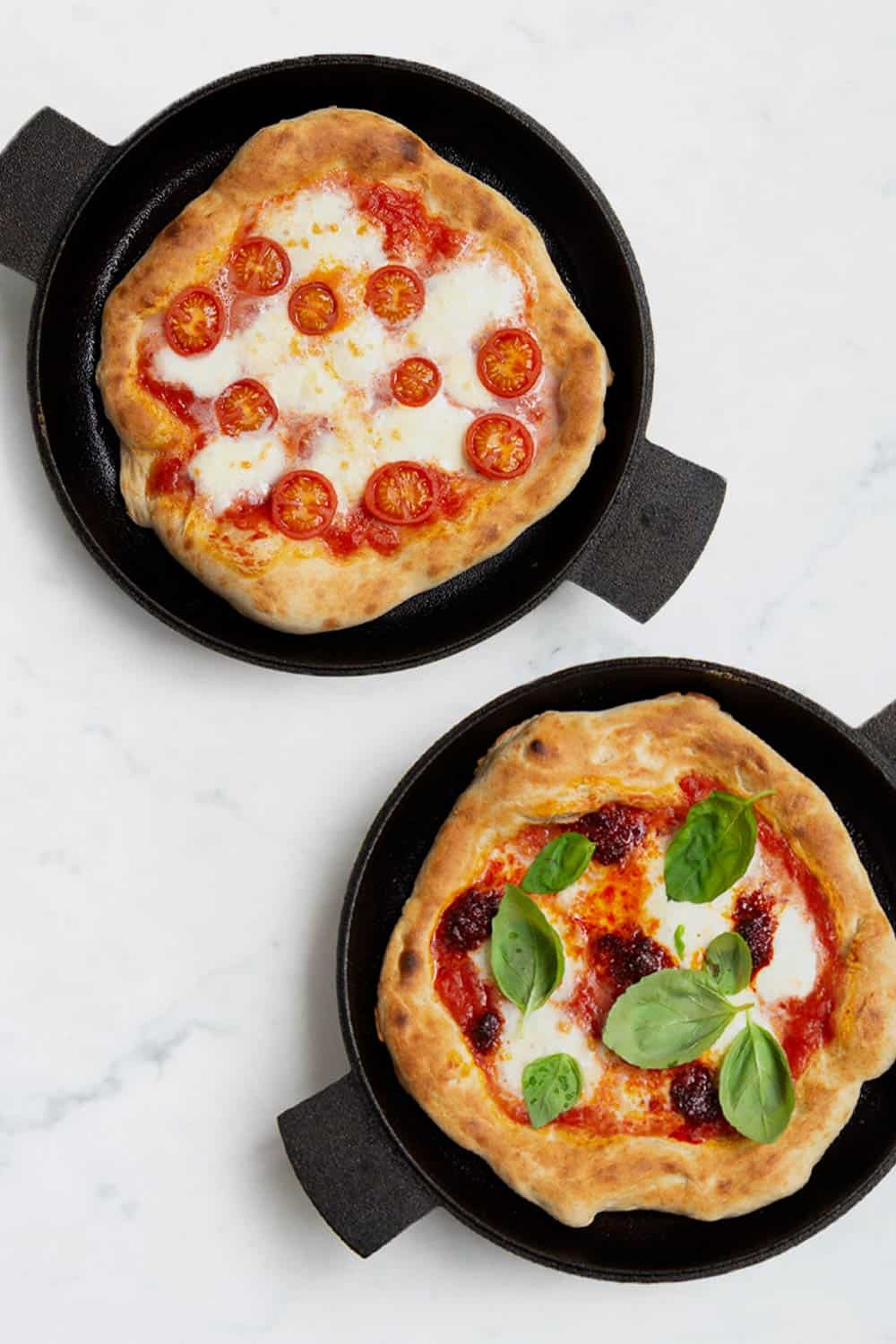
Frying Pan Pizza Recipe
by Nicola Lando
-
Easy

The popularity of frying pan pizzas has boomed in 2020. It’s a quick and efficient way to make great pizzas at home. Many doughs require overnight proving to really develop the flavour, but the dough in our recipe only needs to sit for two hours! We’ve used a combination of milk, malt extract and a little olive oil to achieve a richly flavoured and smooth-textured dough, that’s ready to use on the day it’s made.
Why cook pizzas in a frying pan?
Although a pizza oven creates a wonderfully crisp, puffy base in a matter of minutes, they’re a sizeable investment to have at home. And while you can bake pizzas in the oven, they won’t get that signature, crispy base. That’s where the frying pan method comes in – you can have crispy, puffy pizzas, made in your own kitchen.
The pizza cooks through evenly, and because you’re pre-cooking the bases in a frying pan on the hob, it takes much less time to finish the pizzas under the grill.
How to make pizza in a frying pan at home
Once you’ve got your risen dough, it’s a case of heating an oven-safe frying pan on the hob over a medium heat. Gently stretch your dough out and into a circle, then place it in a dry pre-heated frying pan.
Top with a few tablespoons of crushed San Marzano tomatoes and whatever else you fancy, then cook for a couple of minutes. Use a fish slice or heat-proof spatula to gently peer under and check on the base. Once it’s starting to brown, put the pan under a super-hot grill (we heated ours to 270°C) for around 6-10 minutes, checking regularly.
To enjoy the pizzas at their best, pop them in the middle of the table and let everyone share while the next one cooks.
For specific pizza recipes click through on our topping ideas below.
The pizza base dough
We love Caputo Pizzeria flour, and Molini del Ponte PIZZA flour for their soft texture and fuller flavour. But any 00 flour or strong white flour will work well when making the dough for pizza bases.
Frying pan pizza making equipment
- Mixing bowl
- Large plate
- 28cm oven-safe frying pan (we use Skeppshult)
Pizza topping ideas and recipes
How you top your pizza depends on the flavours you love. Try one of our recipes below:
- Keep it classic by sticking to tomatoes, mozzarella and basil (a Margherita), or add a fiery kick with ’nduja and peppery rocket leaves.
- Thinly sliced mushrooms add an umami flavour which, when paired with truffle oil, makes for an earthy and deeply savoury pizza.
- If you’re after a meaty texture, try adding cooked, crumbled sausage meat on top of the tomato sauce, alongside friarielli broccoli.
Ingredients for the frying pan pizza dough Serves: 4
- 500g 00 pizza flour (or strong white bread flour)
- 7g yeast
- 12g salt
- 150g whole milk
- 175g warm water
- 15g malt extract
- 10g olive oil
Ingredients for pizza sauce
- 400g (1 tin) San Marzano tomatoes in their juice
Method for frying pan pizza dough
- Mix the flour, yeast and salt together in a large mixing bowl. Pour in the milk and warm water (it can be warmer than that you’d use for homemade bread, as the cold milk will cool it down), malt extract and olive oil. Mix well with your hands, squeezing the dough between your fingers to ensure everything is well incorporated. Cover with a plate, and set aside for 20 minutes.
- Now, gently ‘knead’ the dough while it’s still in the mixing bowl. Stretch one edge of the dough 10-20cm into the air, and fold back over the centre. Rotate your bowl by 90 degrees, and do the same again. Repeat 5-10 times. The dough will feel like it could easily break apart, but will tighten up as you go. Cover and leave for 20 minutes.
- Repeat the lift and fold process 2-3 more times, 20 minutes apart. Each time you’ll notice the dough becoming more elastic and smoother to work with.
- Two hours after first mixing the dough, it’s time to shape it. Lift out of the bowl and, using a knife or dough scraper, divide into four equal pieces. Take your first piece of dough and fold any corners into the centre - like an origami fortune teller! It should look more circular. Flip each shaped dough piece over, so the smooth base is on top, and rotate gently between your hands to turn it into a sphere. Set aside on a piece of parchment and shape the next piece. When all four pieces have been shaped, cover with oiled cling film or a damp tea towel and set aside to rise for an hour.
Method for pizza sauce
- Tip the San Marzano tomatoes and juice into a bowl, then use your hands to crush them. Discard the hard yellow stem from each tomato. Set aside.


About the author
Nicola is co-founder and CEO at Sous Chef. She has worked in food for over ten years.
Nicola first explored cooking as a career when training at Leiths, before spending the next decade in Finance. However... after a stage as a chef at a London Michelin-starred restaurant, Nicola saw the incredible ingredients available only to chefs. And wanted access to them herself. So Sous Chef was born.
Today, Nicola is ingredients buyer and a recipe writer at Sous Chef. She frequently travels internationally to food fairs, and to meet producers. Her cookbook library is vast, and her knowledge of the storecupboard is unrivalled. She tastes thousands of ingredients every year, to select only the best to stock at Sous Chef.
Nicola shares her knowledge of ingredients and writes recipes to showcase those products. Learning from Sous Chef's suppliers and her travels, Nicola writes many of the recipes on the Sous Chef website. Nicola's recipes are big on flavour, where the ingredients truly shine (although that's from someone who cooks for hours each day - so they're rarely tray-bakes!).


